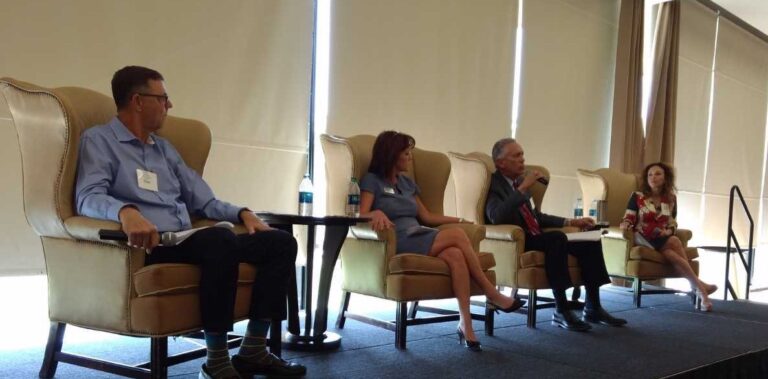By Roland Murphy for Arizona Builder’s Exchange
We don’t have people to do the jobs. We won’t have them for quite a while, and it’s our fault.
160 people filled the ballroom at the Phoenix Country Club on May 18 to hear the somber message, but no one argued against it.
A panel, moderated by Jordan Rose, Rose Law Group founder and president and consisting of Dan Haag, Sundt Construction senior VP and chief administration officer; Jackie Elliott, Central Arizona College president and CEO, and Mike Greenawalt, Rosendin Electric, senior VP of operations, gave the room an overview of the labor situation, how we got here, and were, perhaps, we might go.
Rose’s first question to the panel put the specimen on the board: How did we get here?
Short answer is complicated, but obvious. The G.I. Bill recipients that went into craft trades are retiring or have retired, and a focus on liberal arts education that shuns hands on work has taken its place.
To paraphrase Elliot, we’re telling kids, every kid, it’s better to get a degree in a dying or useless field of study than to get your hands dirty and then wash up and cash a good paycheck.
Student debt recently outpaced credit card debt, and it will only increase in the next 5-10 years.
Greenawalt gave a historical outlay. He recalled his experience in 1979 going for an apprenticeship with 200 people vying for 30 spots.
“We were having a difficult time in the early 2000’s getting apprentices coming to programs,” he said. “Industry associations and numbers were telling us that the workers were aging out.”
And, yet, no one heeded the warning bell. In large part, according to Elliot, because educators had begun pushing the notion that all employers wanted/felt they needed, a “well-rounded graduate with a liberal arts degree,” no matter the position. She stopped just short of referring to it as a failure in American education.
With the advancement of standardized testing and the budget shifts associated with it, industrial arts or “shop” classes have been eliminated in many, if not most, K12 schools across the country, something which caught the almost always flexible and responsive Rose flat-footed.
“You mean there are no more shop classes, anywhere?” she asked.
Greenawalt answered. “Industrial arts programs have been cut from the elementary schools – we’ve done it to ourselves.”
The cultural and perceptive shift away from vocation education, and the lack of education funding and, more importantly, marketing the value of a craft-skills career was decried across the board.
Unfortunately, that marketing outreach should have started and been ongoing 30 years ago, according to the panelists, and now we’re playing catch-up against three decades of indoctrination and policy.
Greenawalt, a highly successful businessman, trades expert and craft worker, mentioned repeatedly the shock and surprise he got throughout his career while attending children’s and business events when people would look at him and ask, “You’re an electrician?”
That stigma is something we as an industry must actively overcome, with positive marketing and directed programs, the panelists agreed.
On the point of directed programs, both Elliot and Haag focused on the Sundt/CAC partnership and its overwhelming degree of success since implementation.
While still competing with other firms for program graduates, Haag noted Sundt’s investment in craftwork training has benefitted both his company and the industry at large. Sundt provides materials, equipment and support in its CAC educational partnership.
Elliot went even farther, praising Sundt’s investment and noting its branding impact. “Everything has Sundt on it, and kids are coming to us and saying they want to be part of the Sundt program. Even if they go to another company at the end of their program, they know Sundt, and the Sundt brand, as something to aspire to.”
Branding and Education are Great, but Where’s the Money?
One thing that was not brought up, either from the host or the audience questions, was the lack of wage growth in either craftwork or other industries.
Since at least 2014, it’s been noted wages for skilled workers in Arizona lag behind those in other states, such as Colorado and Texas, which leads to both a difficulty in drawing new workers and in drawing prior workers back.
A recent Bloomberg article was bold enough to earn the title, “Don’t Fall for Employers’ Whining About the ‘Skills Gap’.” and concluding by saying, “So unless wage growth picks up, the warnings about labor shortages will fall flat,” something that’s been echoed by nearly every expert from the national stage to leaders of the W.P. Carey School at Arizona State University.
A recent survey ranked Phoenix-Mesa-Scottsdale #11 out of 25 for worst paying construction jobs, offering a mean wage of just less than $31K, a full $9K below the national average.
We can promote. We can educate, and we can train to our hearts’ content, but the sad truth is, in the next 10 years, there will be at least one more economic downturn, which will slow down construction and dampen the market, and in which we will probably fail to keep up with promotional investment, where we won’t promote the craft trades or invest in repopulating them, and then when the next uptick happens, we won’t be any better off than we are today. Perhaps, if other markets do all the things we don’t, we’ll even be far worse off.

